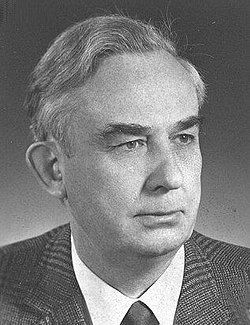Willi Hennig
| Willi Hennig | |
|---|---|

Willi Hennig (1972)
|
|
| Born | Emil Hans Willi Hennig 20 April 1913 Dürrhennersdorf, Germany |
| Died | 5 November 1976 (aged 63) Ludwigsburg, Germany |
| Nationality | German |
| Fields | Taxonomy, Entomology |
| Known for | Cladistics |
| Notable awards | Linnean Medal (1974) |
Emil Hans Willi Hennig (April 20, 1913 – November 5, 1976) was a German biologist who is considered the founder of phylogenetic systematics, also known as the cladistic classification method. In 1945 as a prisoner of war, Hennig began work on his theory of cladistics, which he published in 1950. With his works on evolution and systematics he revolutionised the view of the natural order of beings. As a taxonomist, he specialised in dipterans (ordinary flies and mosquitoes).
Hennig was born in Dürrhennersdorf, Upper Lusatia. His mother Marie Emma, née Groß, worked as a maid and, later, factory worker. His father Karl Ernst Emil Hennig was a rail worker. Willi had two brothers, Fritz Rudolf Hennig, who became a minister, and Karl Herbert, who went missing at Stalingrad in 1943.
In the spring of 1919, Willi Hennig started school in Dürrhennersdorf, and subsequently was at school in Taubenheim an der Spree and Oppach. Rudolf Hennig described the family as calm; his father possessed an even temperament.
As of 1927, Willi Hennig continued his education at the Realgymnasium and boarding school in Klotzsche near Dresden. Here he met his first mentor M. Rost, a science teacher, whom he lived with in a house known as the "Abteilung". Rost had an interest in insects and introduced Hennig to Wilhelm Meise, who worked as a scientist at the Dresdener Museum für Tierkunde (Zoological Museum Dresden). In 1930, Hennig skipped a year, and graduated on February 26, 1932. As early as 1931, Willi Hennig composed an essay entitled Die Stellung der Systematik in der Zoologie ("The state of systematics in zoology") as part of his school work, published posthumously in 1978. It showed his interest as well as his deliberate treatment of systematic problems. Besides school, Hennig worked as a volunteer at the museum and, in collaboration with Meise, saw to the systematic and biogeographical investigation of the "flying" snakes of the genus Dendrophis that became his first published work.
From the summer semester of 1932 onwards, Hennig read zoology, botany and geology at the University of Leipzig. He would continue to visit the Museum in Dresden. There, he met the curator of the entomological collection, the Dipteran expert Fritz Isidor van Emden. Hennig saw him regularly until van Emden was expelled from National Socialist Germany for having a Jewish mother and wife.
...
Wikipedia
